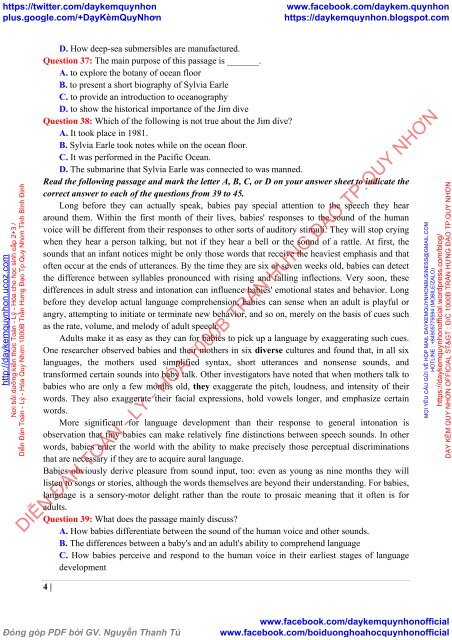Bộ đề thi thử THPTQG 2019 - Môn Toán, Lý, Hóa, Anh - Cả nước - Có lời giải chi tiết (Lần 12) ( 21 đề ngày 01.04.2019 )
https://app.box.com/s/aq6jxik1oqhovk3vxaklhennyfv7fycy
https://app.box.com/s/aq6jxik1oqhovk3vxaklhennyfv7fycy
You also want an ePaper? Increase the reach of your titles
YUMPU automatically turns print PDFs into web optimized ePapers that Google loves.
https://twitter.com/daykemquynhon<br />
plus.google.com/+DạyKèmQuyNhơn<br />
www.facebook.com/daykem.quynhon<br />
https://daykemquynhon.blogspot.com<br />
http://daykemquynhon.ucoz.com<br />
Nơi bồi dưỡng kiến thức <strong>Toán</strong> - <strong>Lý</strong> - <strong>Hóa</strong> cho học sinh cấp 2+3 /<br />
Diễn Đàn <strong>Toán</strong> - <strong>Lý</strong> - <strong>Hóa</strong> Quy Nhơn 1000B Trần Hưng Đạo Tp.Quy Nhơn Tỉnh Bình Định<br />
D. How deep-sea submersibles are manufactured.<br />
Question 37: The main purpose of <strong>thi</strong>s passage is _______.<br />
A. to explore the botany of ocean floor<br />
B. to present a short biography of Sylvia Earle<br />
C. to provide an introduction to oceanography<br />
D. to show the historical importance of the Jim dive<br />
Question 38: Which of the following is not true about the Jim dive?<br />
A. It took place in 1981.<br />
B. Sylvia Earle took notes while on the ocean floor.<br />
C. It was performed in the Pacific Ocean.<br />
D. The submarine that Sylvia Earle was connected to was manned.<br />
Read the following passage and mark the letter A, B, C, or D on your answer sheet to indicate the<br />
correct answer to each of the questions from 39 to 45.<br />
Long before they can actually speak, babies pay special attention to the speech they hear<br />
around them. Wi<strong>thi</strong>n the first month of their lives, babies' responses to the sound of the human<br />
voice will be different from their responses to other sorts of auditory stimuli. They will stop crying<br />
when they hear a person talking, but not if they hear a bell or the sound of a rattle. At first, the<br />
sounds that an infant notices might be only those words that receive the heaviest emphasis and that<br />
often occur at the ends of utterances. By the time they are six or seven weeks old, babies can detect<br />
the difference between syllables pronounced with rising and falling inflections. Very soon, these<br />
differences in adult stress and intonation can influence babies' emotional states and behavior. Long<br />
before they develop actual language comprehension, babies can sense when an adult is playful or<br />
angry, attempting to initiate or terminate new behavior, and so on, merely on the basis of cues such<br />
as the rate, volume, and melody of adult speech.<br />
Adults make it as easy as they can for babies to pick up a language by exaggerating such cues.<br />
One researcher observed babies and their mothers in six diverse cultures and found that, in all six<br />
languages, the mothers used simplified syntax, short utterances and nonsense sounds, and<br />
transformed certain sounds into baby talk. Other investigators have noted that when mothers talk to<br />
babies who are only a few months old, they exaggerate the pitch, loudness, and intensity of their<br />
words. They also exaggerate their facial expressions, hold vowels longer, and emphasize certain<br />
words.<br />
More significant for language development than their response to general intonation is<br />
observation that tiny babies can make relatively fine distinctions between speech sounds. In other<br />
words, babies enter the world with the ability to make precisely those perceptual discriminations<br />
that are necessary if they are to acquire aural language.<br />
Babies obviously derive pleasure from sound input, too: even as young as nine months they will<br />
listen to songs or stories, although the words themselves are beyond their understanding. For babies,<br />
language is a sensory-motor delight rather than the route to prosaic meaning that it often is for<br />
adults.<br />
Question 39: What does the passage mainly discuss?<br />
A. How babies differentiate between the sound of the human voice and other sounds.<br />
B. The differences between a baby's and an adult's ability to comprehend language<br />
C. How babies perceive and respond to the human voice in their earliest stages of language<br />
development<br />
DIỄN ĐÀN TOÁN - LÝ - HÓA 1000B TRẦN HƯNG ĐẠO TP.QUY NHƠN<br />
4 |<br />
MỌI YÊU CẦU GỬI VỀ HỘP MAIL DAYKEMQUYNHONBUSINESS@GMAIL.COM<br />
HOTLINE : +84905779594 (MOBILE/ZALO)<br />
https://daykemquynhonofficial.wordpress.com/blog/<br />
DẠY KÈM QUY NHƠN OFFICIAL ST> : Đ/C 1000B TRẦN HƯNG ĐẠO TP.QUY NHƠN<br />
Đóng góp PDF bởi GV. Nguyễn Thanh Tú<br />
www.facebook.com/daykemquynhonofficial<br />
www.facebook.com/boiduonghoahocquynhonofficial

















